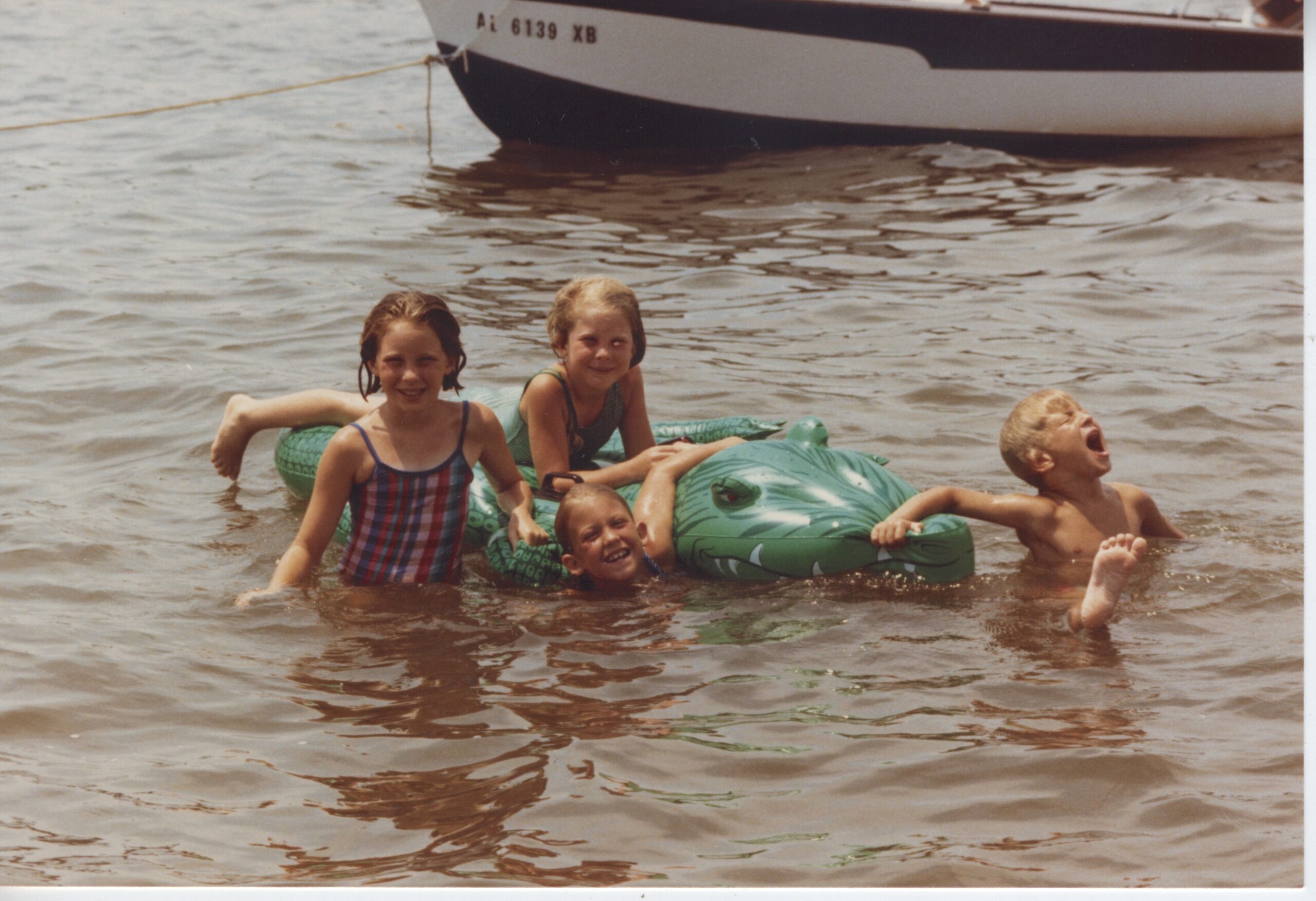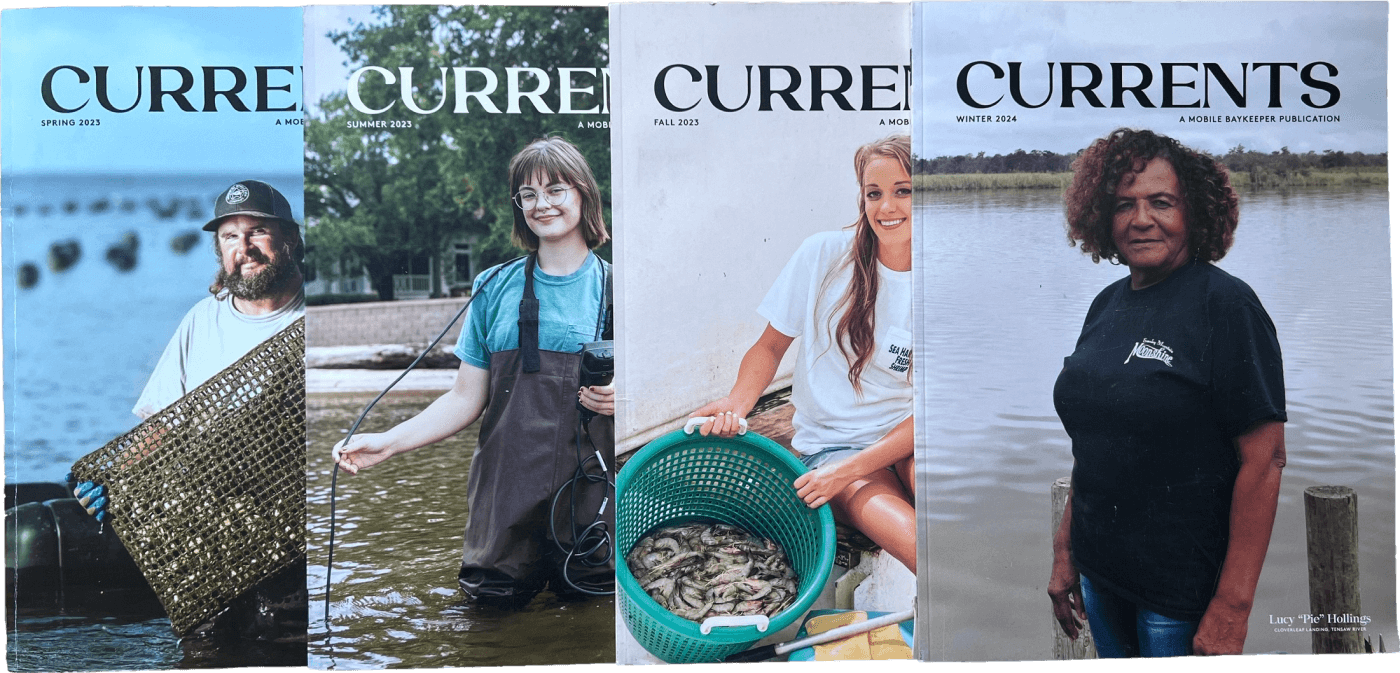
Why We Swim is an article from Vol 5 of CURRENTS magazine – a publication of Mobile Baykeeper.
Growing up in a family of serious swimmers meant our aquatic experiences extended beyond the public pool; most of our swimming occurred in natural bodies of water. My grandfather had purchased property on what would later become Lake Tuscaloosa before the dam was built. My mother, a water enthusiast, could tread water for hours. If she didn’t get into the water often, she would jokingly complain that her “gills” were getting dry.
My father, on the other hand, was not one for relaxing swims. His swims involved ambitious feats, such as crossing the entire lake or venturing far out into the Gulf of Mexico, often causing a bit of concern among us. Swimming with Dad in the Gulf was considered a privilege, as he believed the saltwater had healing properties for various illnesses. While the scientific validity of this belief is dubious, I still like to think of it as true.
Considering the habits of most creatures — land or water-dwelling — it is indeed peculiar that humans engage in both. Animals typically choose one environment for survival. So, why do people swim? Early on, practical reasons drove people to swim — fishing, diving for food, or crossing rivers were essential skills for survival.
Cultures with strong maritime traditions, like those of the Phoenicians and Polynesians, relied on swimming as part of their seafaring lives. Spending extensive time on the ocean made swimming crucial for survival. Archaeological records show that early humans submerged themselves in water for ritualistic purposes. Ritual cleansing, a cornerstone in many religions, often involves full submersion as a symbol of washing away impurities.
As time went on, swimming took a turn toward pleasure. Curiosity led us to swim for enjoyment. Ancient civilizations, including Egypt, Greece, and Rome, incorporated swimming into their athletic games. Modern swimming recreation is centered around fun in the sun, whether at the beach, river, or lake. Swimming is used for relaxation, cooling off, competition, and exercise.
The Alabama Gulf Coast has a robust tradition of swimming dating back to the Choctaw. The Choctaw story of the frog and the turtle’s race conveyed a lesson that arrogance and speed do not guarantee success, echoing the more widely known tale of the tortoise and the hare.
Early European explorers did not share a strong swimming culture. Swimming was deemed unnecessary, undignified, and potentially hazardous due to encounters with skilled native swimmers. Only lower-class maritime workers swam during this period.
Coastal West Africans brought their swimming and fishing traditions to the Gulf Coast after being enslaved, where they continued to live off the water. However, the revocation of access to public swimming places and the relocation of Black communities away from waterways during Reconstruction and the Jim Crow-era led to a decline in these traditions.
Swimming remained associated with the lower class until the late 19th century. The expansion of railroad travel to accommodate the tourism industry, coupled with the belief in bathing to cure illnesses, popularized swimming among more affluent Americans.
For those who grew up around the water in Coastal Alabama in the 20th century, swimming was a way of life. Jimbo Meador, the local legend often referenced in this publication, claims to have swum nearly every day, describing it as “marinating.” However, Jimbo now expresses concern about swimming safety, unsure of the water’s current conditions. While data shows that Mobile Bay is generally safe for swimming, many people are afraid to swim in local waters (Baykeeper performs year-round testing for bacteria at many sites along our waterways. To see the results, you can subscribe here.)
What happens when a culture stops swimming? In the Middle Ages, swimming was banned in many parts of Europe due to concerns about immorality. Here in America, swimming has been banned in many water bodies due to fears of pollution and disease spread. To this day, there are beach closures, even in places like Florida, due to harmful blooms. The aforementioned Black communities suffer drownings at significantly higher rates than their white counterparts.
Why provide this history of swimming? Because swimming is ingrained in our culture. Swimming makes us stronger, more resilient, and more fun. And healthy waterways are necessary for its continuation.
As we approach spring and summer, I encourage you to swim. Let us collectively ensure that no one has to question whether the water is safe.
William Strickland is the Executive Director for Mobile Baykeeper.

Mobile Baykeeper exists to defend and revive the health of the waters of Coastal Alabama. One way we accomplish this is through bacteriological monitoring at several locations in Mobile and Baldwin counties and reporting our findings to the public. The SWIM (Swim Where It’s Monitored) Program’s primary focus is to conduct bacteriological testing and report results of that testing to the public. Samples are tested for Enterococcus and E. coli.
